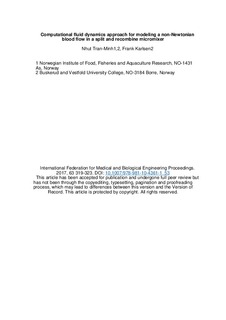| dc.contributor.author | Tran-Minh, Nhut | |
| dc.contributor.author | Karlsen, Frank | |
| dc.date.accessioned | 2018-09-26T11:20:53Z | |
| dc.date.available | 2018-09-26T11:20:53Z | |
| dc.date.created | 2017-10-31T09:52:40Z | |
| dc.date.issued | 2017 | |
| dc.identifier.citation | International Federation for Medical and Biological Engineering Proceedings. 2017, 63 319-323. | nb_NO |
| dc.identifier.issn | 1680-0737 | |
| dc.identifier.uri | http://hdl.handle.net/11250/2564687 | |
| dc.description.abstract | In this work, the blood flow in a passive planar micromixer is analyzed in order to provide a case study for the use of different models of the blood dynamic viscosity in COMSOL Multiphysics. Regarding the Newtonian or non-Newtonian behavior, the blood is best approximated with a non-Newtonian model since its viscosity changes with dependence on the shear rate. The usual Newtonian model of blood viscosity, as well as two non-Newtonian models including Carreau model and the Power law model are used to study the wall shear stress. For the models study, a passive planar micromixer with ellipse-liked micropillars is proposed to operate in the laminar flow regime for high mixing efficiency. | nb_NO |
| dc.language.iso | eng | nb_NO |
| dc.publisher | Springer, Singapore | nb_NO |
| dc.title | Computational Fluid Dynamics Approach for Modeling a Non-Newtonian Blood Flow in a Split and Recombine Micromixer | nb_NO |
| dc.type | Journal article | nb_NO |
| dc.type | Peer reviewed | nb_NO |
| dc.description.version | acceptedVersion | nb_NO |
| dc.rights.holder | © Springer Nature Singapore Pte Ltd. 2018 | nb_NO |
| dc.source.pagenumber | 319-323 | nb_NO |
| dc.source.volume | 63 | nb_NO |
| dc.source.journal | International Federation for Medical and Biological Engineering Proceedings | nb_NO |
| dc.identifier.doi | 10.1007/978-981-10-4361-1_53 | |
| dc.identifier.cristin | 1509165 | |
| cristin.unitcode | 222,0,0,0 | |
| cristin.unitcode | 222,58,4,0 | |
| cristin.unitname | Høgskolen i Sørøst-Norge | |
| cristin.unitname | Institutt for mikrosystemer | |
| cristin.ispublished | true | |
| cristin.fulltext | postprint | |
| cristin.qualitycode | 1 | |
